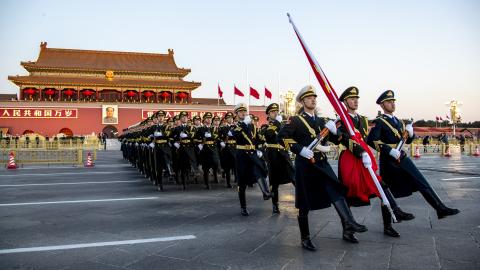Introduction
In April 2023, the Australian government released the officially commissioned but independently produced Defence Strategic Review. Intended to assist the government of Australia with its strategic and defense policies over the next decade and beyond, the report offered the fundamental assessment that the Indo-Pacific region “faces increasing competition that operates on multiple levels—economic, military, strategic and diplomatic—all interwoven and all framed by an intense contest of values and narratives.”1 The Biden administration’s National Security Strategy, which had been released several months earlier (October 2022), stated the challenge in even starker terms: “The People’s Republic of China harbors the intention and, increasingly, the capacity to reshape the international order in favor of one that tilts the global playing field to its benefit.”2
At the heart of these statements is the perception that China poses a systemic and comprehensive challenge, not just to the vital interests and values of the United States and Australia, but to the entire system and order that was cobbled together after the Second World War. These postwar rules, norms, institutions, conventions, practices, alliances, and security relationships have been underwritten by US material power. They constitute a liberal order that is under intense challenge from China.3
This report explores what success in relation to China looks like for the US, Australia, and allies such as Japan. Several substantial and thoughtful pieces have described what victory would look like for China,4 and there have also been many good efforts to describe what victory would look like for the US and its allies, given China’s goals and objectives.
The current report focuses on a US and Australian vision of success in which the geopolitical contest and struggle are enduring and do not end with a victory for any side. Victory generally means defeating an enemy or opponent in a specific context or activity. Unsurprisingly, the term is commonly associated with defeating an enemy during a battle or compelling the unconditional surrender of the enemy when engaging in war. In victory, there is a clear winner and loser.
By way of contrast, success or successful struggle means the accomplishment of an aim or purpose in general or specific contexts. It might include subduing an opponent and attaining victory over that opponent. But success can also be achieved without the strict formal requirement of victory, depending on one’s objective.
The term success is used here because the scope of this report is broader than victory in a traditional war context (even if the use of force is always an option to achieve success or deny it to the opponent). It will be apparent that the Chinese notion of war is far broader than the Western notion. The West holds that war is fought within and across identified air, sea, land, space, and cyber domains, and that war has a discernible beginning and end. In the Chinese conception, war has no boundaries or restrictive form and does not necessarily involve the kinetic use of force. It is material, but also ideational, psychological, and structural.5 Indeed, for the Chinese, the apogee of conflict is to win without fighting, even if the Chinese Communist Party (CCP) sees the environment as one of perpetual struggle. Hence, war may have no formal beginning or end.
For this reason, a US and Australian vision of success cannot simply be about achieving specific key objectives, like maintaining Taiwanese de facto independence or preventing further Chinese militarization of the South China Sea. To be sure, a vision of success is based on certain fundamental end states (such as preventing Chinese material and normative dominance in East Asia). However, it also accepts the likelihood of a constant struggle against a formidable China, just as China assumes the long-term existence of a formidable US with significant allies in the region.
In other words, the authors work on the prudent assumption that China will be neither defeated nor terminally weakened, and that its expansionist ambitions and substantial capabilities will remain. Rather than focusing on a final victory or endpoint, a vision of success conceptualizes an advantageous and enduring state of affairs or system of arrangements in the region that supports the fundamental objectives of the US and its allies in the Indo-Pacific.
This report is about successful struggle, but not in the context of a major war where one side wins decisively and the next step is to establish a sensible peace. This is not to discount the possibility that the use of force could be decisive in shaping the region. But the report focuses on scenarios of an increasingly tense competition and rivalry occurring over the next decade and explores what success looks like in that context. It does not discount the possibility or necessity of limited military action, but does not assume that any such action would be decisive in producing a permanent winner and loser.
Finally, this report focuses on two different but related questions:
- How can the US and Australia counter, constrain, or circumvent the aspects of China’s vision of success that the allies most wish to avoid?
- What does a US and Australian vision of success entail, and why?
The vision of success for the US and Australia elaborated in this report will hold to the following conditions:
- The vision of success is within the capability and prowess of the US and Australia to achieve. It cannot simply assume and flow from US and allied dominance and preeminence. Neither can it rely on an unrealistic prescription for how the US and Australia achieve dominance and preeminence—one that depends on some unexpected collapse in Chinese power and influence.
- The vision needs to be relatively stable and enduring, even as it evolves, and needs to be based on an appropriate degree of institutionalization and socialization.
- The vision can offer an alternative arrangement with China that is plausible and desirable for the US, Australia, and the region.




















